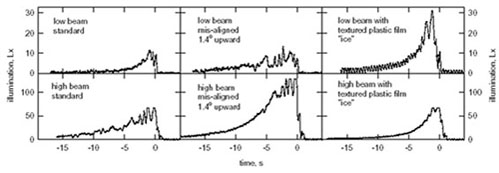Recognition of retroreflective roadsigns
during night driving
Temporal waveforms of the illumination at the driver eyes position were determined in various night traffic and weather conditions (ideal weather and correct aligned lights as compared with dirty lamps and raindrops on the windscreen). The statistics of retinal illumination were analysed, and a computer controlled technique was developed to simulate similar changes of eye illumination. The participant fixated on retroreflective optical stimuli at a distance of 5 m. The participant was then subjected to dazzle, and recovery from the glare took place. The background illumination was in the mesopic range. Experiments showed that at background illumination 0.1 Lx no dazzling took place in case of correctly installed clean headlights. The participant was dazzled if the high beam lamps were incorrectly aligned or cycloplegia was used for pupil dilation. The dazzle time depended on the background illumination level and could increase to three seconds for the illumination changes corresponding to the equivalent speed of vehicles 50 km/h.
Berzinsh J, Ozolinsh M, Cikmacs P, Pesudovs K
Recognition of retroreflective road signs during night driving. In:
de Waard D BK, Moraal J, Tofetti A, ed.
Human Factors in Transportation, Communication, Health and the Workplace.
Maastricht, The Netherlands: Shaker Publishing, 2002: xx-xx In Press.

Figure 3. Time dependencies of the illumination in a car at the position of the driver eyes, when oncoming vehicle is passing with speed 20 km/h with different headlamps switched on and in different lamp conditions
![]() Road signs as PDF (195 Kb)
Road signs as PDF (195 Kb)
![]() Figure 3 as PDF (88 Kb)
Figure 3 as PDF (88 Kb)
![]()
Index of Papers
[ Welcome ][ Publications ]